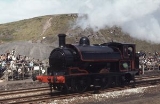
L&YR Class 23
Encyclopedia
The Lancashire and Yorkshire Railway
(L&YR) Class 23 is a class of 0-6-0
ST steam locomotive
. Their main use was for shunting and for short-trip freight working.
The Class 23 0-6-0ST locomotives were rebuilt at Horwich Works
by Aspinall
between 1891 and 1900, using the frames, wheels etc from earlier Barton Wright
0-6-0 tender engines, built 1876-1887. 230 were so converted.
The class was long-lived. The first loco was withdrawn in 1926 by the London Midland and Scottish Railway, but the last survived in use until 1964 with British Railways London Midland Region. 101 were in service at Nationalisation, 20 still in service in 1961.
One locomotive, L&YR 752 (LMS 11456), is now preserved, having been sold to the NCB
for continued operation and is undergoing an overhaul to bring it back to working order by its owners, The Lancashire and Yorkshire Railway Trust, a Registered Charity reg no 1002627.http://www.lyrtrust.org.uk
Lancashire and Yorkshire Railway
The Lancashire and Yorkshire Railway was a major British railway company before the 1923 Grouping. It was incorporated in 1847 from an amalgamation of several existing railways...
(L&YR) Class 23 is a class of 0-6-0
0-6-0
Under the Whyte notation for the classification of steam locomotives, 0-6-0 represents the wheel arrangement of no leading wheels, six powered and coupled driving wheels on three axles, and no trailing wheels...
ST steam locomotive
Steam locomotive
A steam locomotive is a railway locomotive that produces its power through a steam engine. These locomotives are fueled by burning some combustible material, usually coal, wood or oil, to produce steam in a boiler, which drives the steam engine...
. Their main use was for shunting and for short-trip freight working.
The Class 23 0-6-0ST locomotives were rebuilt at Horwich Works
Horwich Works
Horwich Works was a railway works built in 1886 by the Lancashire and Yorkshire Railway in Horwich, near Bolton, in the North West of England when the company moved from its original works at Miles Platting, Manchester.-Buildings:...
by Aspinall
John Aspinall (engineer)
Sir John Audley Frederick Aspinall was a British mechanical engineer who served as Locomotive Superintendent of the Great Southern and Western and Lancashire and Yorkshire Railways. He introduced vacuum brakes to his locomotives in Ireland, a trend which was followed in Britain, and designed...
between 1891 and 1900, using the frames, wheels etc from earlier Barton Wright
William Barton Wright
William Barton Wright was a British mechanical engineer and Locomotive Superintendent of the Lancashire and Yorkshire Railway.-Family:His son Edward William Barton-Wright was a promoter of martial arts: see Bartitsu....
0-6-0 tender engines, built 1876-1887. 230 were so converted.
The class was long-lived. The first loco was withdrawn in 1926 by the London Midland and Scottish Railway, but the last survived in use until 1964 with British Railways London Midland Region. 101 were in service at Nationalisation, 20 still in service in 1961.
One locomotive, L&YR 752 (LMS 11456), is now preserved, having been sold to the NCB
NCB
NCB is a three-letter abbreviation for:* Balanced Noise Criterion, a function for measuring noise levels* Narcotics Control Bureau - the Indian drug enforcement agency.* National Cargo Bureau* Nanyang Commercial Bank...
for continued operation and is undergoing an overhaul to bring it back to working order by its owners, The Lancashire and Yorkshire Railway Trust, a Registered Charity reg no 1002627.http://www.lyrtrust.org.uk

